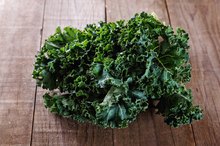What does fact checked mean?
At Healthfully, we strive to deliver objective content that is accurate and up-to-date. Our team periodically reviews articles in order to ensure content quality. The sources cited below consist of evidence from peer-reviewed journals, prominent medical organizations, academic associations, and government data.
- “Journal of Food Science”; Effects of Stir-Fry Cooking with Different Edible Oils on the Phytochemical Composition of Broccoli; D. Moreno, et al.; January 2007
- “Journal of Food Science”; Effects of Stir-Fry Cooking with Different Edible Oils on the Phytochemical Composition of Broccoli; D. Moreno, et al.; January 2007
The information contained on this site is for informational purposes only, and should not be used as a substitute for the advice of a professional health care provider. Please check with the appropriate physician regarding health questions and concerns. Although we strive to deliver accurate and up-to-date information, no guarantee to that effect is made.
Does Cooking Destroy the Phytochemicals in Broccoli & Cauliflower?
Phytochemicals are powerful antioxidant and anti-cancer compounds. Examples of phytochemicals found in broccoli and cauliflower are phenolic acids, carotenoids, sulphoraphane and glucosinolates, such as glucobrassicin and glucoraphanin. Your cooking method is very important in maximizing the availability of phytochemicals. The wrong cooking method will significantly diminish the phytochemical content of your vegetables.
Boiling
When you boil broccoli or cauliflower, you lose large amounts of phytochemicals, which leach out, or are released, into the boiling water in a short period of time. Studies published in the “Journal of Food Chemistry" in January 2004 and April 200 revealed that after only two minutes boiled broccoli florets lose at least 95 percent of their sulphoraphane content, 62 percent of their phenolic acid content, 23 percent of their glucobrassicin content and 17 percent of their glucoraphanin content. Phytochemicals also leach out from broccoli and cauliflower stems. These losses dramatically diminish the phytochemical intake and the health benefits of these vegetables.
- When you boil broccoli or cauliflower, you lose large amounts of phytochemicals, which leach out, or are released, into the boiling water in a short period of time.
Microwaving
Boiled Vegetables vs. Steamed
Learn More
The loss of phytochemicals in microwaving broccoli or cauliflower in water is similar to that for boiling. The high heat still causes nutrients to leach out into the water and diminishes nutrient content. After two minutes, microwaved broccoli florets lose at least 98 percent of their sulphoraphane content and 62 percent of their phenolic acid content. However, you do maintain glucobrassicin and glucoraphanin concentrations. So although microwaving destroys a large amount of phytochemicals, it is a better option than boiling. To lower phytochemical losses due to leaching, minimize the amount of water added to cook your vegetables. Also avoid the use of plastic containers in microwaving to prevent exposure to dangerous plasticizers.
- The loss of phytochemicals in microwaving broccoli or cauliflower in water is similar to that for boiling.
Stir-Fry
If you stir-fry broccoli or cauliflower, the type of oil you use will determine the level of phytochemical loss after cooking. According to a January 2007 article in the “Journal of Food Science," refined olive oil and sunflower oil destroy 49 percent and 37 percent of broccoli glucosinolates after three and a half minutes, respectively 1. These oils, along with extra virgin olive, soybean and safflower oils, also significantly reduce phenolic acid content. However, peanut oil does not significantly alter either glucosinolate or phenolic acid content in this time frame. So to retain phytochemicals, use peanut oil to stir-fry your broccoli or cauliflower.
- If you stir-fry broccoli or cauliflower, the type of oil you use will determine the level of phytochemical loss after cooking.
Steaming
What Peppers Are Good for Lowering Cholesterol?
Learn More
Steaming broccoli and cauliflower retains a significant amount of their phytochemicals. Although you lose small amounts of certain nutrients, these losses are not as dramatic as those found from boiling or microwaving. Steamed broccoli florets lose only about 35 percent of their sulphoraphane content. They also retain more of their phenolic acid and glucosinolate content than stir-fried broccoli in peanut oil. Therefore, steam your broccoli and cauliflower for two to four minutes to maximize their phytochemical content.
- Steaming broccoli and cauliflower retains a significant amount of their phytochemicals.
- Therefore, steam your broccoli and cauliflower for two to four minutes to maximize their phytochemical content.
Related Articles
References
- “Journal of the Science of Food and Agriculture”; Phenolic compound contents in edible parts of broccoli inflorescences after domestic cooking; F. Vallejo, et al.; July 2003
- “Journal of Food Chemistry”; Phenolics, ascorbic acid, carotenoids and antioxidant activity of broccoli and their changes during conventional and microwave cooking; D. Zhang, et al.; January 2004
- “Journal of Food Science”; Effects of Stir-Fry Cooking with Different Edible Oils on the Phytochemical Composition of Broccoli; D. Moreno, et al.; January 2007
- “Journal of Food Chemistry”; Cooking method significantly effects glucosinolate content and sulforaphane production in broccoli florets; R. Jones, et al.; April 2010
- Broccoli, raw. U.S. Dept. of Agriculture. FoodData Central. Updated April, 2019.
- World's Healthiest Foods. Broccoli. The George Mateljan Foundation. No date.
- Fiber. Eatright.org. Academy of Nutrition and Dietetics. November 2, 2018
- Kaczmarczyk MM, Miller MJ, Freund GG. The health benefits of dietary fiber: beyond the usual suspects of type 2 diabetes mellitus, cardiovascular disease and colon cancer. Metabolism. 2012;61(8):1058–1066. doi:10.1016/j.metabol.2012.01.017
- Bahadoran Z, Tohidi M, Nazeri P, Mehran M, Azizi F, Mirmiran P. Effect of broccoli sprouts on insulin resistance in type 2 diabetic patients: a randomized double-blind clinical trial. Int J Food Sci Nutr. 2012;63(7):767-71. doi:10.3109/09637486.2012.665043
- Blekkenhorst LC, Sim M, Bondonno CP, et al. Cardiovascular Health Benefits of Specific Vegetable Types: A Narrative Review. Nutrients. 2018;10(5):595. Published 2018 May 11. doi:10.3390/nu10050595
- How Do I Follow a Healthy Eating Pattern? American Heart Association. 2020
- Cruciferous vegetables and cancer prevention. National Cancer Institute. Updated June 7, 2012.
- Vasanthi HR, Mukherjee S, Das DK. Potential health benefits of broccoli--a chemico-biological overview. Mini Rev Med Chem. 2009;9(6):749-59. doi:10.2174/138955709788452685
- Rajendran P, Rengarajan T, Nandakumar N, Palaniswami R, Nishigaki Y, Nishigaki I. Kaempferol, a potential cytostatic and cure for inflammatory disorders. Eur J Med Chem. 2014;86:103-12. doi:10.1016/j.ejmech.2014.08.011
- Sugita Y, Makino T, Mizawa M, Shimizu T. Mugwort-mustard allergy syndrome due to broccoli consumption. Case Rep Dermatol Med. 2016;2016:8413767. doi:10.1155/2016/8413767
- Vitamin K. Consumer Fact Sheet. National Institutes of Health Office of Dietary Supplements. Updated February 24, 2020
- Labensky, SR, Hause, AM. On Cooking: A Textbook of Culinary Fundamentals. 3rd ed. Upper Saddle River, NJ: Prentice Hall, 2003: 617.
- Linus Pauling Institute. Micronutrients for Health.
Writer Bio
Dozie Onunkwo has been a health and fitness researcher and writer since 2007. His articles are featured in magazines such as "Southern Indiana Fitness Source" and the World Bodybuilding & Fitness Federation's "Fit & Firm Magazine." Onunkwo earned his Ph.D. in biomedical engineering from Purdue University.









